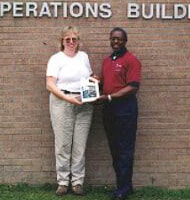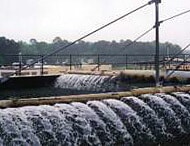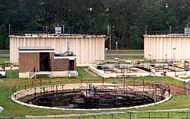Results: Testimonial
"We started using Strike® last summer and the flies are gone."
Relief from Filter Flies
Water is a limited resource that needs to be protected. Wastewater treatment plants do their part by speeding up nature's own process for cleaning water and returning it to rivers, lakes and oceans for reuse, but tiny 1/16 inch long insects jeopardize a treatment plant's success.
These tiny gray filter flies (Psychoda spp.) with light-colored wings are common aquatic insects that lay their eggs in irregular masses where decomposing organic materials are found, such as sewage plant filters and garbage disposal units.
The Heart of the Plant
Filter flies infest the heart of a wastewater treatment system. The trickling filters are the "heart of the plant," according to Grega St. John, public utilities project manager at OMI's Hinesville, Ga. plant. Operations Management International Inc. (OMI), is a privatization company that has contracted with the City of Hinesville for 14 years to treat approximately 7.1 million gallons per day of wastewater.
A live system of micro-organisms and biological growth helps remove pollutants from the wastewater as it is filtered over the biomass. Unfortunately, the biomass in the first-stage trickling filter is an ideal environment for filter flies to breed because of the constant temperature. Excess larvae in the trickling filter can be a detriment to the treatment process. Small amounts of the larvae may help digest the waste, but excessive amounts are a hindrance.
The flies are not strong fliers and wind will blow them into offices and control panels. Besides being a nuisance, filter flies sneak into the casing and wiring of electrical control panels which can cause pumps and computers to shut down. "This can put the entire plant out of operation and the flies become a maintenance, safety and cost issue," St. John comments.
Chlorinating to Control Filter Flies
Some treatment plants chlorinate trickling filters to help kill the flies. "The problem with chlorination is the risk to the mass at the heart of your plant. If you chlorinate enough to kill the larvae, you must be careful not to use enough to kill your growth," explains St. John. "This is a really tricky situation. You have to chlorinate a filter without hurting the system."
"We tried chlorination, but it wasn't very effective," says St. John. "Chlorine is a highly hazardous, toxic chemical with a lot of regulations. It can be an extreme danger to employees." According to St. John, the wastewater industry is examining alternate disinfection methods.
Finding a Solution
"When one OMI project has a problem, it is likely another project within the company has had a similar experience and developed a solution," says St. John. So when the Hinesville staff struggled with filter flies, they turned to OMI's Barnesville, Ga., project to find answers. OMI's Barnesville and Stuart, Fla. projects, use Strike® Midge Control by Zoëcon to control filter flies. Strike® is an insect growth regulator (IGR) that is a copy of natural products in an insect's body, that disrupts normal development and prevents the emergence of adult flies.
"We started using Strike® last summer and the flies are gone," says St. John. "We adjust the amount of product we feed into the system according to the flow level. If we consistently feed the product at the proper rate, there isn't a problem," she says. "It's drastic. When we feed the product correctly we won't see any flies. If we notice one or two flies, then we know something is wrong," she adds.
The active ingredient in Strike®, a water-based liquid concentrate, is one of the most environmentally compatible insect control products on the market. Because the active ingredient in Strike® affects only insects, there is no need for concern about the effect on beneficial microbes.
Strike® can be applied with a chemical feed pump at an initial rate of five ounces per one million gallons of flow. If the previous day's flow is seven million gallons, then the Hinesville plant would run 35 ounces of product. This rate is used for two weeks to provide an initial knockdown of the flies. Once the flies are gone, a residual must be kept in the system so the flies do not build up again.
Most wastewater treatment plants discharge water that is even cleaner than the water in the receiving stream, according to St. John. Now the Hinesville project can control the tiny filter flies and continue to protect water for the future.


